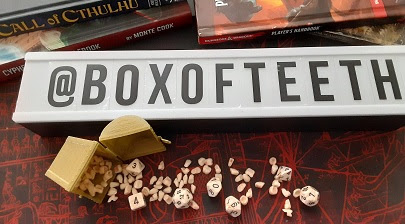More on the Brood Still sensuous despite her advanced age, Evigra'tha radiates a beauty bordering on beatific. The thousand, and last, child of primordial Iktokris rumor has it that her father was one of the myriad of gods once responsible for the Dark Mother’s imprisonment who sought Iktokris to make amends. If Evigra'tha is a demi-god of sorts, that would aptly explain her longevity and power. Like the rest of the brood, she is clothed in a soft, black downy from crown to hoof. Said hooves are shod with well-beaten iron with stripes of glossy, ebon chitin showing between the metal. Evigra'tha’s curled horns are of the same shelled material, though she also has a second set arching backwards from her temple amid a mane of black hair. The bridge of her nose and forehead is flat, rather like a goat, and her dark eyes contain no iris. Swathed in loose silk clothing that does little to hide a body ripened to perfection by childbirths, Evigra'tha leaves most of her ba

Box of Teeth is a blog dedicated to horror role-playing games. It features essays, monsters, and other bits and baubles to help game masters and players get the most out of rpg experiences.
Become a Patron by clicking here.